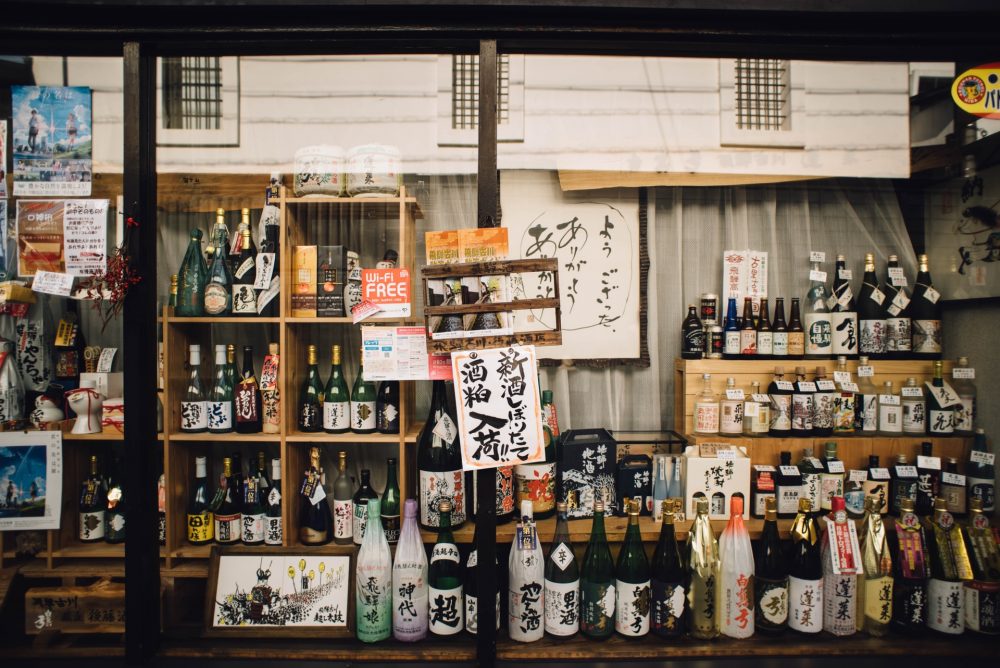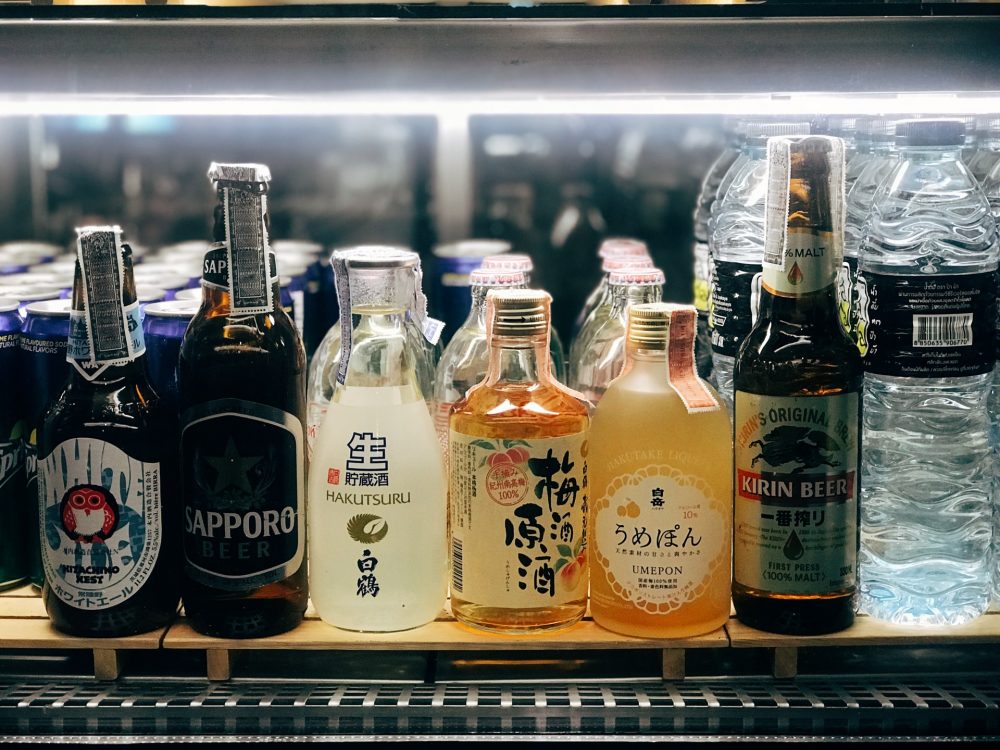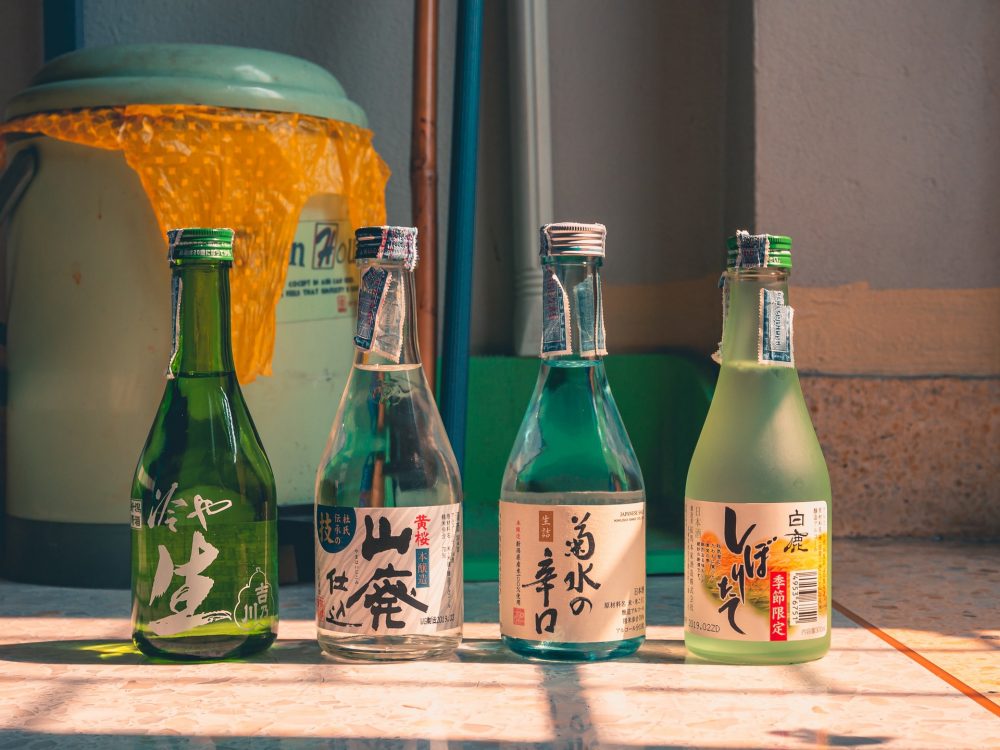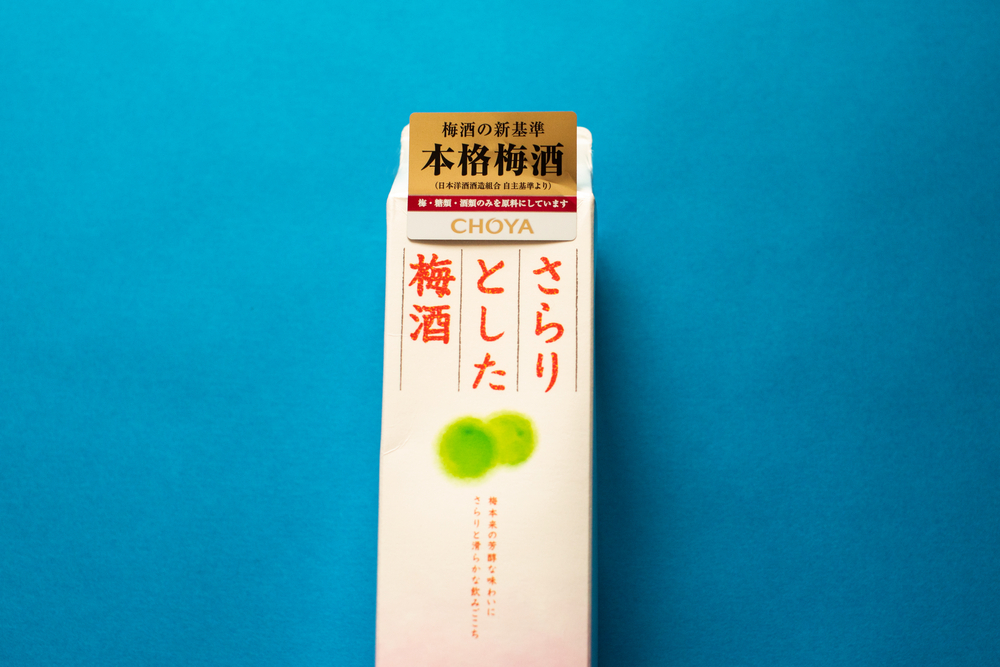When we think Japanese alcohol, we think sake. But the best Japanese drinks include fantastic beer, whiskey, and more. And then there’s all the Japanese soda and soft drinks to get to know.
When it comes to all things culinary, Japan is legendary the world over for its varied and wonderful foods. Sushi, onigiri, okonomiyaki, takoyaki, the list goes on and on. When we think of Japanese drinks, our minds often leap quickly to sake. The truth is, however, that Japan is a land of varied and exciting drinks, alcoholic and otherwise.

Here, you’ll find a rundown of the best and most popular Japanese drinks. First, we’ll cover the most common Japanese alcohol (Japanese beer, whiskey, sake, and more). Then we’ll move onto Japanese soft drinks and Japanese soda, all of which offer an exciting amount of variety.
The world of Japanese drinks is a wide open one with a lot of variety to explore, whether you’re looking for the best Japanese alcohol or just some delicious Japanese soda. So, let’s jump in and explore. And don’t forget to say kanpai!
Japanese Alcohol
Japanese alcoholic drinks exist on a broad and varied spectrum. Many Japanese drinks are inspired by iconic Western drinks like whiskey and beer. Others, like sake, are uniquely Japanese alcoholic drinks. Here are all of the most famous must-try Japanese drinks, from Japanese whiskey to the best sake in Japan.

Japanese Beer
First introduced to Japan by Dutch merchants at the former trading post Dejima in Nagasaki, during the Edo period. While Dutch beer was widely available, local commercial brands Sapporo and Kirin began production in the 1870s to meet the burgeoning demand (with other big brands Asahi and Suntory trailing not far behind).

Like in many countries around the world, the popularity of craft beer has skyrocketed in Japan, with a gradual increase in interest over the past twenty-five years or so. In Japan, the capital of Tokyo and the second city of Osaka have very much taken the mantle of becoming craft beer hubs in Japan.
LIke many drinks in Japan, there is some etiquette involved when drinking beer. You may notice immediately that it isn’t drunk in pints or steins like it typically is in Europe. Instead, Japanese beer is enjoyed by the glass, straight from a larger shared bottle. It’s customary to pour your drinking partner’s beer for them and vice versa.

Some typical Japanese beers and craft beers you will see in any izakaya or bar in Japan include:
Asahai Super Dry — A classic dry lager with the two favourable properties of being cheap and easy to drink.
Hitachino Nest Beer — Marked by it’s adorable squat bottle and colourful owl wrapping, this is one of the most popular Japanese craft beers currently on the market.
Kirin — An iconic label, Kirin’s pale larger is one of the oldest and most popular beers in Japan. They also offer the unique Kirin Ichiban Shibori, which has a distinctive bittersweet taste and is also extremely popular.
Sapporo — From the northern island of Hokkaido, and named after the island’s capital city, black label Sapporo beer has a distinctive, mature taste that is popular with many.
Sapporo Yebisu Beer — Considered a more upmarket beer with a slightly higher price tag than the others, this beer is made following strict and traditional German beer brewing techniques.
Try: The Japanese version of a Bloody Mary, the Red Eye Cocktail is a mixture of Japanese beer, tomato juice, and lemon (with the optional extras of a shot of vodka and raw egg).
Read More: A Guide to Japanese Kokeshi Dolls
Shochu
The national spirit of Japan, and easily one of the most iconic Japanese drinks, shochu is a clear, distilled spirit with similarities to vodka. What separates shochu from vodka is the fact that it is made with many different types of base. These include rice and sweet potato, though the most common base for shochu is barley.

The distilling process for Japanese shochu is more complex than that for vodka, and shochu can be distilled multiple times and even fermented or aged. Shochu contains no sugar and has a lower alcohol content than vodka, making it much easier to drink over the course of a night out and even pairs well with meals making it a popular izakaya staple drink.
Iichiko is one of the most popular shochu brands in Japan, producing over ten different types of the drink with varying smoothness and flavour.
Try: Oolong Hai is a shochu drink that needs to be tried when you visit Japan. This Japanese cocktail of oolong tea and shochu or lemon sour, also known as lemon chuhai, is a mixture of soda, shochu, and lemon or yuzu.
Sake
Probably one of the most famous Japanese alcoholic drinks (or Japanese drinks in general). Internationally, sake is starting to be treated in the same way as wine or beer, and taken seriously as an artform in its own right. However, if you ask for sake at a bar in Japan you may be faced with some confusion.
In Japanese, ‘sake’ simply means ‘alcoholic drink’ so, to be more specific, you’ll want to ask for ‘nihonshu’ which literally translates to ‘Japanese alcohol’ though, more specifically, refers to what we know as sake: one of the most important Japanese drinks in existence.

Sake is a spirit made from rice which has undergone a long process of polishing and fermentation using a mold known as koji. You may see the term junmai (純米) meaning ‘pure rice’ on your bottle of sake; this note separates pure rice sake from non pure rice sake.
Pure rice sake means that no sugar or alcohol have been added, using just koji, yeast, and rice. However, non-junmai sake results in different flavour profiles within the sake and can be overall easier to drink.
The quality of Japanese sake is typically determined by the level of polishing it has overgone. Rice that has been polished down to 60% (known as Daiginjo and Junmai Daiginjo) is considered premium, with incredibly complex flavours and a price tag to match.

Futsushu, on the other hand, is a more common table sake, and has been polished to 70% and will be cheaper. These are just a couple of the many factors that separate sake; which is, as you can tell, an incredible diverse Japanese alcohol. Much like wine, you can delve into the world, the history, and the traditions of sake for years and years.
Try: Sparkling sake. It’s been around for over a hundred years but is becoming increasingly popular for its crisp and clean finish, and its fun factor.
Sake brands to try:
Hakkaisan Tokubetsu Junmai — A clean, crisp, and dry sake from the mountainous Niigata prefecture.
Dewazakura Cherry Bouquet Oka Ginjo — A premium, fragrant, and light sake which pairs well with any food.
Kikusui Perfect Snow — A cloudy, thick, and creamy sake. It’s less filtered, resulting in a milky colour and works well in cocktails.
What is Atsukan?
Atsukam is sake that has been heated to fifty degrees, with several other names for warm sake heated to different temperatures. Warm sake enhances the notes of the sake, thus becoming sweeter or more bitter than if the sake is enjoyed cold.
Tip: If you’re interested in learning more about Japanese sake, make sure to check out Brain Ashcraft’s book on sake. This book takes you through its history, brewing, and flavour notes.

Japanese Whiskey
Japan is regarded as one of the world’s great whiskey-making countries, with a long history and eleven main distilleries across the country.
Japan was initially inspired by Scottish brewing techniques. Masataka Taketsuru, who was born into a family of sake makers, studied in Glasgow and brought his newfound knowledge to Shinjiro Torii, an entrepreneur in the alcohol market.
Together, Taketsuru and Torii founded the Suntory Yamazaki distillery in the early 1900s and whiskey was commercially sold in Japan for the first time.

Fun fact: The name Suntory derives from Torii-san. The company’s founder simply reversed and tweaked his own name, Torii-san, to create the name Suntory.
A few of the big names in whiskey brewing in Japan include: Suntory, Nikka (which was also founded by Masataka Taketsuru after breaking partnership with Shinjiro Torii), and Akashi. Akashi comes from White Oak Distillery, which owns one of Japan’s oldest whiskey licenses, and which is Japan’s highest-altitude distillery. It has been in operation for over a century.
You can also dig into the world of Ji-Whisky, which are, essentially, Japanese craft whiskeys that are unique to their local region but can diverge widely in terms of ingredients and quality.

Make sure to visit one of Japan’s popular and numerous whiskey bars, where you can see the real passion Japan has for its whiskey and get to know some of the many whiskey based cocktails available. Japanese author Haruki Murakami famously ran a whiskey bar before working full-time as a writer.
Try: Whiskey Highball — A popular drink in the 1950s; a mix of whiskey and sparkling (carbonated) water or Oyuwari. Highball is the Japanese equivalent of a hot toddy, which is made by mixing hot water and whiskey.
Umeshu (Japanese Plum Wine)
A delicious and extremely popular Japanese alcohol, with a history that can be traced back to the Edo period, there are currently over three hundred brands available on the market. Japanese plum wine is made from ume (plums) that are harvested in June and are then soaked in liquor (typically shochu or brandy) and sugar.

For umeshu using real plums, you will see the note Honkaku Umeshu (本格梅酒) but cheaper versions will use flavourings to replicate the plum taste and won’t have this label. Real umeshu is often touted for its health benefits, including relieving exhaustion and constipation.
Popular brands to try include: Choya umeshu which is made using traditional methods with fruit that has matured for at least a year and Yamazaki umeshu which has matured slowly in casks and has a deep, elegant flavour.
Try: Yuzushu — Made a similar way to umeshu, and with striking similarities to limoncello, this refreshing citrus drink is made by soaking the peel of the winter yuzu fruit in shochu. It comes in varying degrees of sweet and sour flavours and is a very popular addition to Japanese cocktails.
Awamori
This is one of the more unique Japanese drinks, being native to Okinawa and, with a six-hundred-year history, it is believed to be a predecessor to shochu. Traditional techniques are still used in the brewing of awamori today. These techniques use indica (also called Thai rice) and unique black koji mold to make the spirit (the high humidity in Okinawa helps facilitate the mold).
Awamori is preserved for a long time, giving the flavours time to develop. This means it is often referred to as ‘aged sake’. Awamori that has been aged for three years or more is known as ‘kusu’.
Japanese Soft Drinks
If you’ve never visited Japan, chances are one of the legends you’ve heard about modern Japan is the sheer number of vending machines (in Japanese: 自動販売機 or jidouhanbaiki).

If you’ve visited or lived in Japan, you can confirm that this legend is true. Vending machines are everywhere in Japan, from halfway up mountains to the edges of rural fields. With the popularity of vending machines in Japan comes a swathe of popular Japanese soft drinks. In the West — especially in the United States — Coca Cola and Pepsi dominate the soft drinks market.
In Japan, unsurprisingly, it’s the Japanese soft drinks brands like Calpico and Mitsuya that reign supreme. Every Japanese soft drink found below can be seen and enjoyed at most vending machines in Japan (with the exception of Yakult, which is found in every supermarket).
Japanese soft drinks, Japanese milk tea, and Japanese canned coffee are all must-dry drinks when you visit Japan. The variety of brands and flavours is impressive, and the convenience of the country’s vending machines cannot be overstated.
This is not an exhaustive list of every soft drink in Japan but it does provide an excellent overview of the most popular and commonly-found Japanese soft drinks (including Japanese bottled tea and canned coffee).
Japanese Green Tea (Bottled)
Bottled tea is big in Japan. Every vending machine stocks it and multiple brands produce it. Perhaps the most popular Japanese green tea is Ooi Ocha, produced by Itoen. As the bottle’s label says, this is unsweetened Japanese green tea.

In Japan, it’s very common for the brands that are most famous for their beers and whiskeys (Asahi, Kirin, Suntory) to also sell soft drinks and bottled Japanese green tea. You can easily find in vending machines, supermarkets, and online bottles of Japanese green tea, lemon tea, black tea, oolong tea, and more; all produced by recognisable beer brands like Asahi and Kirin.
There are as many types and flavours of bottled Japanese teas as there are KitKats. Every vending machine you pass may offer a different flavour, or even just a differently-branded Japanese green tea for you to try. Find your favourite!
Read More: Types of Japanese Tea, History, and How to Brew Them
Japanese Milk Tea (Royal Milk Tea)
Deserving of its own dedicated segment in this list is Japanese milk tea (typically known in Japan as Royal Milk Tea). While green tea, lemon tea, and oolong tea all tend to overlap, Japanese milk tea is something all its own.

Do a little digging through history and you’ll find a surprising amount of British influence on Japan. Or, rather, Indian influence by way of British sailors, traders, military, and colonisers (sorry, world). The best culinary example is Indian curry, brought to Japan by British sailors.
It doesn’t stop with food, though. Japanese milk tea is a very obviously evolved form of English breakfast tea, made by suffusing Indian black tea with a drop of milk. In Japan, this type of tea is commonly referred to as royal milk tea (or ロイヤルミルクティー).
In true Japanese form, this popular drink has been refined, perfected, and bottled for your convenience. The most popular bottled Japanese milk tea is probably Afternoon Black Tea (午後の紅茶 or Gogo no Kocha) produced by Kirin.
Gogo no Kocha comes in a variety of flavours, including royal milk tea, and “Straight Tea” (black without milk). This is another one of the countless Japanese drinks you’ll find at any vending machine in Japan.
Fun fact: Some vending machines in Japan exclusively stock hot drinks and keep them heated so that, when you buy one, it comes out warm to the touch. These drinks are, of course, typically bottled teas and Japanese canned coffee. Speaking of which…
Japanese Canned Coffee
Coffee is a big deal wherever you go in the world, but there are specific countries in which it is a slightly bigger deal. Countries that do coffee a little differently. The Netherlands and Denmark are the best European examples of this. In Asia, it’s Japan that has its own unique approach to coffee.

While canned coffee can be found almost anywhere these days, and companies like Starbucks sell their own via supermarkets, canned coffee is indeed a Japanese invention. In Japan, it is typically referred to as can coffee (缶コーヒー or kan kohi).
As mentioned above, you’ll find Japanese canned coffee in every vending machine, both in the cold ones and the hot ones. The brands are very distinctly recognisable and you’ll see their logos everywhere you go. Without a doubt, the biggest name in Japanese canned coffee is Boss Coffee (owned by Suntory). I have no idea why but the logo of Boss Coffee is an illustration of William Faulkner.
You may also commonly see Tommy Lee Jones’ face on Boss Coffee posters, adverts, or even vending machines (for the same reason many Brits associate mobile phone company EE with Kevin Bacon.
Calpico Soda
To clear up any confusion, the actual name of Calpico is Calpis. In Japan and everywhere else in the world, it is known as Calpis. Everywhere, that is, except the United States, where the name was altered to Calpico. The reasons are obvious but we’ll leave it up to you to decide if you think they were necessary.
Whether you call the brand Calpico or Calpis, their drinks are everywhere in Japan. Original Calpis is fairly unique amongst Japanese soft drinks (and all Japanese drinks, in fact) for being a watery, milky, uncarbonated, yogurt-esque kind of drink. Put simply, there’s nothing quite like Calpis.
Calpico Soda, however, is a popular variant of Calpis which, as its name suggests, is carbonated. Both original Calpis and Calpico Soda are perhaps most similar to yogurt-based drinks like Yakult (see below). They’re milky and slightly acidic in flavour.
Ramune
Ramune stands shoulder-to-shoulder with Calpis and Pocari Sweat (see below) as one of the most popular Japanese drinks around. What makes Ramune visually unique is the fact that the bottles are sealed with a marble.
Ramune is sold in glass bottles, sealed at the top with a marble, which has made it rather aesthetically famous around the world. You open the bottle by pushing the marble into the glass bottle, where it then rattles around as you drink it. Ramune is often called Japanese marble soda for this reason.

If you’ve ever eaten Pocky or Japanese KitKats, you know how a vast variety of sometimes strange flavours is a key part of the fun when it comes to Japanese snacks. Ramune is the equivalent of Pocky in the world of Japanese drinks.
The original flavour of Ramune is lemon-lime but popular flavours include fruits like watermelon, peach, apple, grape, and strawberry Ramune. Then there are the more unique Ramune flavours like curry, kimchi, teriyaki, and even takoyaki.
Ramune has 50+ flavours and, for that reason, as well as its legacy as a Japanese marble soda, it is easily one of the most fun and varied Japanese drinks around.
Pocari Sweat
As previously mentioned, Pocari Sweat is a big deal in Japan. Found in every Japanese vending machine alongside Japanese green tea and Japanese canned coffee, Pocari Sweat is everywhere. The name Pocari Sweat leaves a lot to be desired. In fact, of the two people writing the article, one of us refuses to even try it. The other loves it (because Pocari Sweat is brilliant).

The reason behind the off-putting name is simple: Pocari Sweat is a sports drink, and its name implies a refuelling of everything you lose when you sweat. Pocari Sweat is easily the most popular sports drink in Japan, though it tends to have a less extreme effect on the body than other sports drinks. It’s a very refreshing companion if you happen to go for a long hike on a hot day.
If you’re wondering how it tastes, Pocari Sweat is uncarbonated, slightly sweet, and wonderfully refreshing. It’s kind of like water but better. Water plus.
Mitsuya Cider
As a Brit, it took some getting used to the idea that ‘cider’ in Japan and Korea is not an exclusively apple-flavoured alcohol. In East Asia, cider typically just means some kind of fruit-flavoured soda. Mitsuya Cider is, without a doubt, the most popular fruit soda amongst Japanese drinks. For an easy comparison, it is most similar to Sprite but, unsurprisingly, it also comes in a decent variety of fruit flavours.
When I first arrived in Japan, I was passionately obsessed with grape flavour Mitsuya Cider.

Oronamin C
This is one of those Japanese drinks that’s an absolute classic, as is made pretty clear by its vintage-looking label and bottle design. Oronamin C is also typically found amongst other Japanese soft drinks on the shelves of vending machines around the country.
There’s not much to this one. As the name suggests, Oronamin C is a Japanese soda with an emphasis on providing the one drinking it with a healthy dose of vitamin C. That’s it. Nice and simply; nice and healthy.
It’s the iconic 1960s logo, the glass bottle, and the easy-to-remove bottle cap that perhaps make Oronamin C one of the more iconic Japanese drinks. But, at its core, it’s just a healthy dose of vitamins in soda form.
Yakult
Yakult probably doesn’t take much explaining. It’s everywhere. A lot of people probably don’t realise the fact that it’s a Japanese drink, however. Growing up in the UK, Yakult was everywhere, and very overpriced, but it was invented in Japan by the company Yakult Honsha.
Promoted as a drink that helps with healthy digestion, Yakult has been something of a low-key global trend for a long time. You’ll still find it on supermarket shelves in Japan and, while it is everywhere, it’s still one of the most iconic Japanese drinks around.



